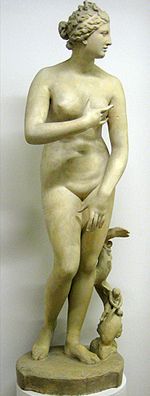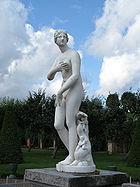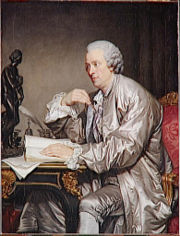
Venus de' Medici
Encyclopedia

Greek mythology
Greek mythology is the body of myths and legends belonging to the ancient Greeks, concerning their gods and heroes, the nature of the world, and the origins and significance of their own cult and ritual practices. They were a part of religion in ancient Greece...
goddess
Goddess
A goddess is a female deity. In some cultures goddesses are associated with Earth, motherhood, love, and the household. In other cultures, goddesses also rule over war, death, and destruction as well as healing....
of love
Love
Love is an emotion of strong affection and personal attachment. In philosophical context, love is a virtue representing all of human kindness, compassion, and affection. Love is central to many religions, as in the Christian phrase, "God is love" or Agape in the Canonical gospels...
Aphrodite
Aphrodite
Aphrodite is the Greek goddess of love, beauty, pleasure, and procreation.Her Roman equivalent is the goddess .Historically, her cult in Greece was imported from, or influenced by, the cult of Astarte in Phoenicia....
. It is a 1st century BC marble copy, perhaps made in Athens, of a bronze original Greek sculpture, following the type of the Aphrodite of Cnidos, which would have been made by a sculptor in the immediate Praxitelean
Praxiteles
Praxiteles of Athens, the son of Cephisodotus the Elder, was the most renowned of the Attic sculptors of the 4th century BC. He was the first to sculpt the nude female form in a life-size statue...
tradition, perhaps at the end of the century. It has become one of the navigation points by which the progress of the Western classical tradition is traced, the references to it an outline of the changes of taste and the process of classical scholarship. It is housed in the Uffizi
Uffizi
The Uffizi Gallery , is a museum in Florence, Italy. It is one of the oldest and most famous art museums of the Western world.-History:...
, Florence
Florence
Florence is the capital city of the Italian region of Tuscany and of the province of Florence. It is the most populous city in Tuscany, with approximately 370,000 inhabitants, expanding to over 1.5 million in the metropolitan area....
, Italy.
Origin
The goddess is depicted in a fugitive, momentary pose, as if surprised in the act of emerging from the sea, to which the dolphin at her feet alludes. The dolphin would not have been a necessary support for the bronze original.It bears a Greek inscription CLEOMENES SON OF APOLLODORUS OF ATHENS on its base. The inscription is not original, but in the 18th century the name "Cleomenes" was forged on sculptures of modest quality to enhance their value, while the inscription on the Venus de' Medici was doubted in order to ascribe the work to one of various highly-thought-of names: besides Praxiteles
Praxiteles
Praxiteles of Athens, the son of Cephisodotus the Elder, was the most renowned of the Attic sculptors of the 4th century BC. He was the first to sculpt the nude female form in a life-size statue...
the less-likely names of Phidias
Phidias
Phidias or the great Pheidias , was a Greek sculptor, painter and architect, who lived in the 5th century BC, and is commonly regarded as one of the greatest of all sculptors of Classical Greece: Phidias' Statue of Zeus at Olympia was one of the Seven Wonders of the Ancient World...
or Scopas
Scopas
Scopas or Skopas was an Ancient Greek sculptor and architect, born on the island of Paros. Scopas worked with Praxiteles, and he sculpted parts of the Mausoleum of Halicarnassus, especially the reliefs. He led the building of the new temple of Athena Alea at Tegea...
. The restorations of the arms was made by Ercole Ferrata
Ercole Ferrata
Ercole Ferrata was an Italian sculptor of the Roman Baroque.-Biography:A native of Pellio Inferiore, near Como, Ferrata initially apprenticed with Alessandro Algardi, and became one of his prime assistants...
, who gave them long tapering Mannerist
Mannerism
Mannerism is a period of European art that emerged from the later years of the Italian High Renaissance around 1520. It lasted until about 1580 in Italy, when a more Baroque style began to replace it, but Northern Mannerism continued into the early 17th century throughout much of Europe...
fingers that did not begin to be recognized as out of keeping with the sculpture until the 19th century.
The Venus de' Medici is the name piece under which are recognized many replicas and fragments of this particular version of Praxiteles' theme, which introduced the lifesize nude representation of Aphrodite. Though this particular variant is not identifiable in any extant literature, it must have been widely known to Greek and Roman connoisseurs. Among replicas and fragments of less importance, the closest in character and finest in quality is a marble Aphrodite at the Metropolitan Museum of Art
Metropolitan Museum of Art
The Metropolitan Museum of Art is a renowned art museum in New York City. Its permanent collection contains more than two million works, divided into nineteen curatorial departments. The main building, located on the eastern edge of Central Park along Manhattan's Museum Mile, is one of the...
, described below.
Such sculptures are described as "Roman copies", with the understanding that these were produced, often by Greek sculptors, anywhere under Roman hegemony "say, between the dictatorship of Sulla and the removal of the Capital to Constantinople
Constantinople
Constantinople was the capital of the Roman, Eastern Roman, Byzantine, Latin, and Ottoman Empires. Throughout most of the Middle Ages, Constantinople was Europe's largest and wealthiest city.-Names:...
, 81 B.C. to A.D. 330" Their quality may vary from work produced by a fine sculptor for a discerning patron, to commonplace copies mass-produced for gardens.
Discovery and display

Francis Haskell
Francis Haskell was an English art historian, whose writings placed emphasis on the social history of art.He read history at King's College, Cambridge and became a Fellow there in 1954...
and Nicholas Penny
Nicholas Penny
Nicholas Penny, FSA is a British art historian. Since Spring 2008 he has been director of the National Gallery in London....
remarked. It was published in the collection at the Villa Medici
Villa Medici
The Villa Medici is a mannerist villa and an architectural complex with a garden contiguous with the larger Borghese gardens, on the Pincian Hill next to Trinità dei Monti in Rome, Italy. The Villa Medici, founded by Ferdinando I de' Medici, Grand Duke of Tuscany and now property of the French...
, Rome, in 1638, given three plates in the anthology of the most noble sculptures that the ravages of time had spared in Rome compiled by François Perrier, Segmenta nobilia signorum et statuarum que temporis dentem invidium evase, Rome 1638. The Venus was already known by 1559, it now appears, for a bronze reduction of it was among the series of the most famous Roman sculptures that were featured on a cabinet completed in that year; it was commissioned by Nicolò Orsini, conte di Pitigliano, as a gift to Philip II of Spain
Philip II of Spain
Philip II was King of Spain, Portugal, Naples, Sicily, and, while married to Mary I, King of England and Ireland. He was lord of the Seventeen Provinces from 1556 until 1581, holding various titles for the individual territories such as duke or count....
: the sculptures were by the Dutch sculptor trained in Benvenuto Cellini
Benvenuto Cellini
Benvenuto Cellini was an Italian goldsmith, sculptor, painter, soldier and musician, who also wrote a famous autobiography. He was one of the most important artists of Mannerism.-Youth:...
's atelier, Willem van Tetrode, called Guglielmo Fiammingo in Italy.
.jpg)
Though visitors to Rome like John Evelyn
John Evelyn
John Evelyn was an English writer, gardener and diarist.Evelyn's diaries or Memoirs are largely contemporaneous with those of the other noted diarist of the time, Samuel Pepys, and cast considerable light on the art, culture and politics of the time John Evelyn (31 October 1620 – 27 February...
found it "a miracle of art", it was sent to Florence in August 1677, its export permitted by Innocent XI
Pope Innocent XI
Blessed Pope Innocent XI , born Benedetto Odescalchi, was Pope from 1676 to 1689.-Early life:Benedetto Odescalchi was born at Como in 1611 , the son of a Como nobleman, Livio Odescalchi, and Paola Castelli Giovanelli from Gandino...
, it was thought, because it stimulated lewd behavior. In the Tribuna of the Uffizi it was a high point of the Grand Tour
Grand Tour
The Grand Tour was the traditional trip of Europe undertaken by mainly upper-class European young men of means. The custom flourished from about 1660 until the advent of large-scale rail transit in the 1840s, and was associated with a standard itinerary. It served as an educational rite of passage...
and was universally esteemed as one of the half-dozen finest antique statues to have survived, until a reaction in taste began to set in during the 19th century, in the form of a few dissenting voices (Haskell and Penny p. 325). Luca Giordano
Luca Giordano
Luca Giordano was an Italian late Baroque painter and printmaker in etching. Fluent and decorative, he worked successfully in Naples and Rome, Florence and Venice, before spending a decade in Spain....
made hundreds of drawings of it, Samuel Rogers
Samuel Rogers
Samuel Rogers was an English poet, during his lifetime one of the most celebrated, although his fame has long since been eclipsed by his Romantic colleagues and friends Wordsworth, Coleridge and Byron...
made daily appointments with it, Zoffany included it in his 1778 Tribuna of the Uffizi
Tribuna of the Uffizi (painting)
The Tribuna of the Uffizi by Johann Zoffany is a painting of the north-east section of the Tribuna room in the Uffizi in Florence, Italy.-Production:...
, and Lord Byron devoted five stanzas of Childe Harold to describing it. It was one of the precious works of art shipped to Palermo in 1800 to escape the rapacious French, to no avail: such diplomatic pressure was brought to bear that the Vénus de Medicis was shipped to Paris in 1803. After Napoleon's fall it arrived back in Florence 27 December 1815.
The Metropolitan Museum's Aphrodite
The marble Aphrodite at the Metropolitan Museum of ArtMetropolitan Museum of Art
The Metropolitan Museum of Art is a renowned art museum in New York City. Its permanent collection contains more than two million works, divided into nineteen curatorial departments. The main building, located on the eastern edge of Central Park along Manhattan's Museum Mile, is one of the...
, New York, is a close replica of the Venus de' Medici. The pose of the head is not in doubt, for it did not break off when other breaks occurred, in which the arms were irrevocably lost. On the plinth is the left foot, with part of the dolphin-and-tree-trunk support, and a trace of the missing right foot, restored by a cast, for the sculpture was in two sections, which were joined by casts taken of the Venus de' Medici's lower legs. For dating the replicas, attention is focussed on the minor details of the dolphins that were added by the copyists, in which stylistic conventions come to the fore: the Metropolitan dates its Aphrodite of the Medici type to the Augustan period.
The Metropolitan Aphrodite was in the collection of Count von Harbuval genammt Chamaré in Silesia
Silesia
Silesia is a historical region of Central Europe located mostly in Poland, with smaller parts also in the Czech Republic, and Germany.Silesia is rich in mineral and natural resources, and includes several important industrial areas. Silesia's largest city and historical capital is Wrocław...
, whose progenitor Count Schlabrendorf made the Grand Tour
Grand Tour
The Grand Tour was the traditional trip of Europe undertaken by mainly upper-class European young men of means. The custom flourished from about 1660 until the advent of large-scale rail transit in the 1840s, and was associated with a standard itinerary. It served as an educational rite of passage...
and corresponded with Johann Joachim Winckelmann
Johann Joachim Winckelmann
Johann Joachim Winckelmann was a German art historian and archaeologist. He was a pioneering Hellenist who first articulated the difference between Greek, Greco-Roman and Roman art...
.

Modern copies
The Medici Venus is one of the most-copied antiquities. Louis XIVLouis XIV of France
Louis XIV , known as Louis the Great or the Sun King , was a Bourbon monarch who ruled as King of France and Navarre. His reign, from 1643 to his death in 1715, began at the age of four and lasted seventy-two years, three months, and eighteen days...
had no less than five, marbles by Carlier
Carlier
Carlier is a Francophone surname, shared by several personalities :* Vincent Carlier, a French footballer* one of the protagonists in Joseph Conrad's story An Outpost of Progress* Dominique Carlier , footballer and coach...
, Clérion
Jean-Jacques Clérion
Jean-Jacques Clérion was a French sculptor who worked mainly for King Louis XIV.Clérion was born in either Aix-en-Provence or Trets. For much of his career he worked on the Chateau de Versailles, including many of the famous garden sculptures, such as the "Apollo Fountain"...
, Coysevox
Antoine Coysevox
Charles Antoine Coysevox , French sculptor, was born at Lyon, and belonged to a family which had emigrated from Spain...
and Frémery
Nicolas Frémery
Nicolas Frémery was a French 17th century sculptor, best known for his marble copies of the Medici Venus, the Apollino and other works by classical and Hellenistic sculptors. He also produced a Faustina and a Urania for the gardens of the Palace of Versailles.-References:...
, and a bronze by the Keller brothers. (Haskell and Penny, p. 325). In lead, copies of the Venus de' Medici stand in many English and European gardens, sometimes protected by small temples; in small bronze reductions it figured among the most familiar of the antiquities represented in collectors' cabinets: in Greuze
Jean-Baptiste Greuze
Jean-Baptiste Greuze was a French painter.-Early life:He was born at Tournus, Saône-et-Loire. He is generally said to have formed his own talent; this is, however, true only in the most limited sense, for at an early age his inclinations, though thwarted by his father, were encouraged by a...
's portrait of Claude-Henri Watelet
Claude-Henri Watelet
Claude-Henri Watelet was a rich French fermier-général who was an amateur painter, a well-respected etcher, a writer on the arts and a connoisseur of gardens. Watelet's inherited privilege of farming taxes in the Orléanais left him free to pursue his avocations, art and literature and gardens...
, ca 1763-65, the connoisseur and author of L'Art de peindre is shown with calipers and a notebook, regarding a bronze statuette of the Venus de' Medici, as if in the act of deducing the ideal proportions of the female figure from the sculpture's example. The Venus de' Medici was even reproduced in Sèvres biscuit porcelain, which had the matte whiteness of marble.
American
United States
The United States of America is a federal constitutional republic comprising fifty states and a federal district...
sculptor Hiram Powers
Hiram Powers
Hiram Powers was an American neoclassical sculptor.-Biography:The son of a farmer, Powers was born in Woodstock, Vermont, on the July 29, 1805. In 1818 his father moved to Ohio, about six miles from Cincinnati, where the son attended school for about a year, staying meanwhile with his brother, a...
based his 1844 statue The Greek Slave
The Greek Slave
The Greek Slave is a marble statue in Raby Castle, carved in Florence by American sculptor Hiram Powers in 1844. Copies of the statue were displayed in a number of venues around Great Britain and the United States, and it quickly became one of Powers' most famous and most popular works...
on the Venus de' Medici.

